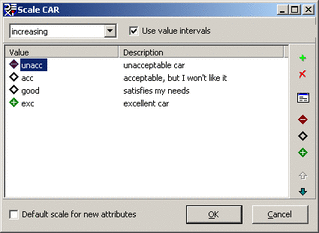Scale Editor
Scale Editor is a window in which you can create and edit one attribute scale. Basically, a scale is just an ordered or unordered list of values; you can add and delete these values, give them names and optional descriptions, change their order and define their bad or good class.

Workspace
Scale Editor consists of:
Value list: each value has a name (usually a short string) and an optional description (used only for documentation).
Scale order entry field at the top: here you can define scale ordering: unordered, increasing (recommended) and decreasing.
The checkbox Use value intervals specifies whether or not intervals can be used with this scale.
Toolbar at the right: provides command buttons.
The field Default scale for new attributes: when checked, this scale will be automatically assigned to all attributes created hereafter in the Model Page.
Commands
To invoke a command, you may either:
press a button shown in the toolbar, or
select an item from the pop-up menu that appears after right-clicking the mouse button.
Scale Editor provides the following commands:
 Add value: Inserts a new value into the list. The default name
of this value is ‘new value’, and you may change this name immediately
after insertion.
Add value: Inserts a new value into the list. The default name
of this value is ‘new value’, and you may change this name immediately
after insertion.
 Delete value: Deletes the value that is currently
selected in the value list.
Delete value: Deletes the value that is currently
selected in the value list.
F2 (keyboard): Rename value: Opens a small in-line field in which you can quickly rename the currently selected value.
 Edit value: Opens a dialogue in which you can edit both
the name and description of the currently selected value.
Edit value: Opens a dialogue in which you can edit both
the name and description of the currently selected value.
 Set bad: Set the class of the currently selected value
to bad.
Set bad: Set the class of the currently selected value
to bad.
 Set neutral: Set the class of the currently selected
value to ‘neutral’ (nor bad nor good).
Set neutral: Set the class of the currently selected
value to ‘neutral’ (nor bad nor good).
 Set good: Set the class of the currently selected value
to good.
Set good: Set the class of the currently selected value
to good.
 Move up: Moves the currently selected value one place up
in the list.
Move up: Moves the currently selected value one place up
in the list.
 Move down: Moves the currently selected value one place
down along the list.
Move down: Moves the currently selected value one place
down along the list.
Remarks
Editing a scale (especially adding and deleting values) may affect already defined utility functions. DEXi tries to adapt the affected functions so that their ‘meaning’ is preserved as much as possible, but you should be careful and verify all affected functions after making such changes.
Increasing scales are strongly recommended: they improve the comprehensibility of models and simplify the definition of utility functions.
The concept of value ‘class’ (bad, neutral, good) is meaningful only
with ordered scales. Thus, the commands 

 do not work with unordered scales. For ordered scales,
classes must be ordered, too. Therefore, classes can be assigned only so
that zero or more bad values are followed by zero or more neutral
values, which are then followed by zero or more good values.
do not work with unordered scales. For ordered scales,
classes must be ordered, too. Therefore, classes can be assigned only so
that zero or more bad values are followed by zero or more neutral
values, which are then followed by zero or more good values.